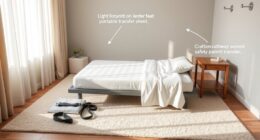To create an effective emergency kit for an elderly loved one, focus on safety, health, and ease of access. Include medical supplies, essential documents, and communication devices in waterproof containers. Pack nutritious food, hydration, personal hygiene items, and mobility aids tailored to their needs. Keep safety features like grab bars and emergency lights ready, and regularly check and update supplies. Continue exploring ways to customize your kit for maximum preparedness in any situation.
Key Takeaways
- Assess home safety hazards and mobility needs to ensure quick access and fall prevention for seniors during emergencies.
- Include essential medical supplies, documentation, and emergency contact information in waterproof, organized containers.
- Pack non-perishable, easy-to-prepare foods, hydration supplies, and nutritional supplements tailored to elderly dietary needs.
- Equip with appropriate mobility aids and accessibility tools to support safe movement and emergency evacuation.
- Regularly inspect, update, and maintain the kit’s contents, power sources, and safety devices to ensure readiness at all times.
Assessing the Unique Needs of Seniors
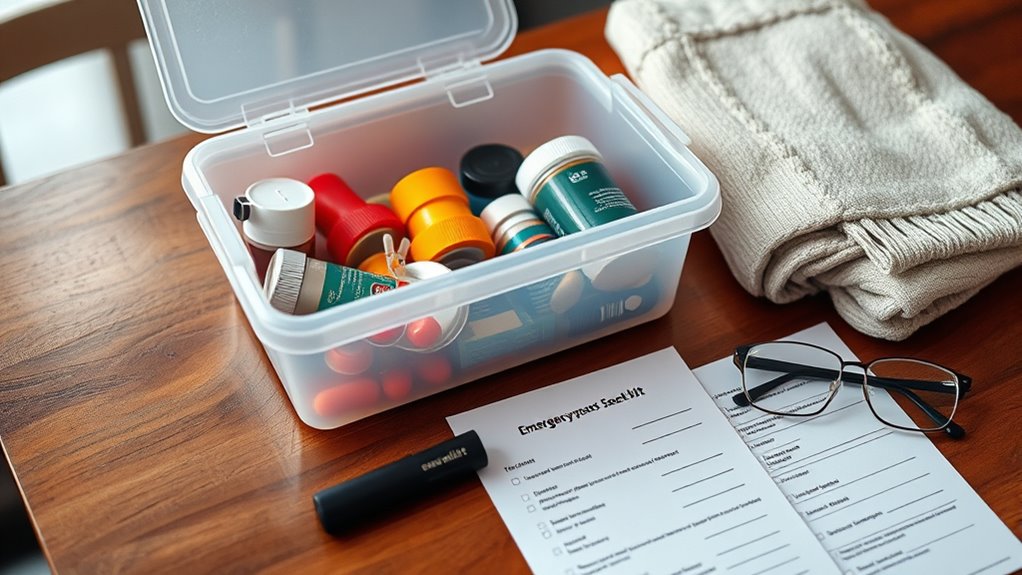
Understanding the unique needs of seniors is essential when creating an effective emergency preparedness kit. You should prioritize home safety by identifying hazards like loose rugs, poor lighting, or clutter that could cause falls or injuries during an emergency. Consider their mobility and sensory limitations to guarantee access to essential items quickly. Social support plays a critical role; think about how neighbors, family, or caregivers can assist during crises. Keep contact information for social support networks visible and up to date. Including safety devices such as grab bars or emergency alert systems can enhance home safety. Regularly reviewing these aspects helps you tailor your kit to your loved one’s specific needs, giving you peace of mind knowing they’re better protected in an emergency. Additionally, understanding how essential oils for health support can be incorporated into daily routines may help in managing stress or discomfort during stressful situations. Recognizing the importance of personal emergency response systems can further improve immediate assistance when needed. Being aware of home technology can also facilitate monitoring and communication during emergencies, offering additional safety measures. Incorporating home safety assessments can help identify potential hazards proactively, ensuring the environment remains as secure as possible. Moreover, staying informed about disaster preparedness education can empower seniors and their caregivers to respond more effectively in various emergency scenarios.
Essential Medical Supplies and Documentation

Having the right medical supplies and documentation readily available is essential for ensuring your loved one’s safety during an emergency. Proper medication management prevents missed doses or overdoses, so include all current prescriptions, a list of dosages, and administration instructions. Medical history documentation helps responders understand their health background quickly. Keep these organized in a waterproof container. Use the table below for guidance:
| Medical Supplies | Documentation |
|---|---|
| Prescription medications | Medical history records |
| First aid supplies | List of allergies and conditions |
| Emergency contact info | Medication management instructions |
Having these items prepared ensures quick access and accurate care, reducing stress during critical moments. Additionally, comprehensive emergency preparedness can help families respond more effectively and confidently in crisis situations. Incorporating tuning techniques such as proper documentation and organized supplies can significantly improve response efficiency during emergencies. Moreover, leveraging automation’s role in business intelligence can streamline the process of maintaining and updating emergency information, ensuring data remains current and accessible when needed. Properly understanding the importance of prophetic dreams can also offer insights during uncertain times, fostering a sense of spiritual guidance and readiness.
Food and Hydration Supplies
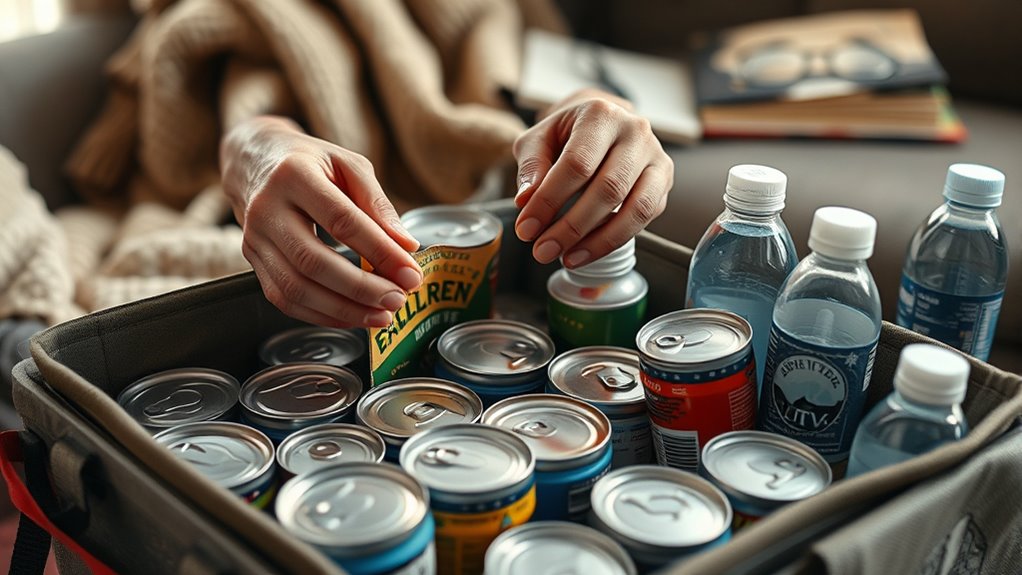
You need to include non-perishable food options that are easy to prepare and long-lasting. Don’t forget to pack hydration essentials like bottled water and electrolyte drinks to stay energized. Ensuring these supplies are accessible can make a big difference during an emergency. Incorporating mindfulness techniques such as deep breathing can also help manage stress in unexpected situations by creating a calming environment.
Non-perishable Food Options
When preparing an emergency kit for seniors, selecting the right non-perishable food and hydration supplies is crucial to guarantee they stay nourished and hydrated during emergencies. Focus on shelf-stable snacks like granola bars, nuts, or dried fruit, which are easy to store and require no refrigeration. Canned fruits are excellent options for providing essential vitamins and a comforting taste, plus they have a long shelf life. Opt for fruits packed in juice rather than syrup to reduce sugar intake. Include a variety of these foods to prevent boredom and ensure balanced nutrition. Also, consider easy-open cans or pull-tab packaging to make access simple and safe. Properly stored, these non-perishable foods will help maintain energy levels and support overall health during emergencies. Incorporating nutritional supplements such as vitamin tablets or electrolyte drinks can further help meet the specific health needs of seniors during crises. Additionally, understanding how to assess nutritional adequacy can ensure that the selected foods meet the dietary needs of elderly individuals in emergency situations. A focus on nutritional balance is essential for maintaining health and preventing deficiencies when access to fresh foods is limited.
Hydration Essentials
Including reliable hydration options in your emergency kit guarantees seniors can stay properly hydrated during crises. To do this, pack bottled water, electrolyte drinks, and hydration tablets. These supplies help maintain fluid intake when access to clean water is limited. Consider adding a hydration tracking sheet or a simple log to monitor daily fluid intake, ensuring they’re drinking enough. Remind your loved ones to sip fluids regularly, especially if they have health conditions affecting hydration. Keep a reusable water bottle and a small, easy-to-open cup handy. Proper hydration supports overall health, prevents dehydration, and keeps energy levels steady. Regularly checking air quality can help identify when hydration needs may increase due to environmental factors. Recognizing emergency preparedness guidelines can help you better plan for and respond to hydration needs during unexpected situations. Being aware of hydration management strategies can ensure that seniors stay safe and healthy in any emergency. Educating seniors on nutrient retention in juices and hydration supplies can further enhance their resilience during emergencies. Additionally, understanding city dynamics can assist in locating nearby resources and safe spots during crises. By preparing these hydration essentials, you empower seniors to manage their fluid intake effectively during emergencies, promoting safety and well-being.
Personal Hygiene and Comfort Items

Personal hygiene and comfort items are essential components of an elderly emergency preparedness kit because maintaining cleanliness and comfort can help prevent infections and reduce stress during stressful situations. Including these items guarantees you can stay fresh and feel more at ease. Consider packing:
- Travel-sized soap, hand sanitizer, and moist wipes for easy personal hygiene
- Soft, breathable blankets and comfortable clothing to keep warm and relaxed
- Toothbrush, toothpaste, and a comb to maintain daily grooming routines
These comfort items help preserve dignity and boost morale during emergencies. Keeping personal hygiene supplies accessible supports health and prevents illness. Comfort items, on the other hand, provide emotional reassurance, making challenging situations more manageable. Additionally, electric bikes can be useful for mobility and transportation needs during emergencies, especially for seniors who may have difficulty walking long distances. This mobility aid can enhance independence and ease evacuation efforts. Incorporating emergency communication devices can also be crucial for maintaining contact with loved ones and emergency services during crises. Maintaining a supply of skincare products can help prevent skin irritation and infections caused by stress or limited mobility. Together, they create a sense of normalcy amidst chaos.
Communication Devices and Emergency Contacts
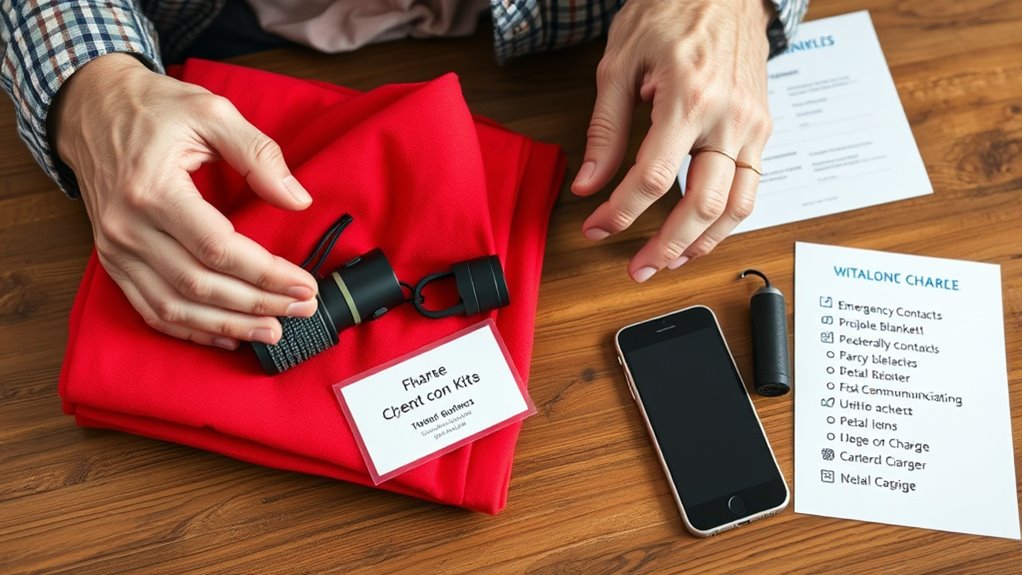
Having the right communication devices and emergency contacts in place guarantees you can quickly reach help or loved ones during a crisis. Make sure your phone is charged and equipped with essential smartphone apps, such as emergency alert apps and health trackers. Keep a list of emergency hotlines, including local police, fire, and medical services, easily accessible. Share this list with trusted family members and friends. Consider having a backup device, like a basic cell phone, in case your primary device fails. Regularly update your emergency contacts and test your communication tools to ensure they work when needed.
| Device/Contact Type | Purpose | Notes |
|---|---|---|
| Smartphone apps | Quick access to help | Install and test regularly |
| Emergency hotlines | Immediate assistance | Save in contacts |
| Backup device | Redundant communication | Keep charged and ready |
Safety and Mobility Aids

Choosing the right mobility device guarantees you can move safely during an emergency, whether it’s a wheelchair, walker, or cane. Emergency accessibility tools, like grab bars or portable ramps, can make a big difference in maneuvering unexpected situations. Assess your needs carefully to keep your mobility secure when it matters most.
Mobility Device Selection
Selecting the right mobility device is essential for ensuring safety and independence during an emergency. Your choice depends on your mobility needs, space constraints, and the environment you’ll face. When considering wheelchair selection, think about stability, ease of transfer, and comfort. For scooter options, evaluate battery life, maneuverability, and terrain adaptability. To picture your options:
- A lightweight, foldable wheelchair for easy storage and transport
- A sturdy power wheelchair with extra support for longer distances
- An all-terrain scooter capable of handling uneven surfaces
Choosing the right device ensures you can move safely and confidently. Remember, the ideal mobility aid matches your specific needs, making emergency evacuation and daily routines more manageable. Proper selection enhances your independence and peace of mind.
Emergency Accessibility Tools
Once you’ve identified the right mobility device, adding emergency accessibility tools can substantially improve safety during a crisis. Adaptive technology, such as voice-activated controls or smartphone apps, helps you stay connected and receive important updates. Auditory alerts are vital for alerting you to emergencies, especially if you have hearing difficulties. These alerts can include loud alarms, voice notifications, or vibrating alerts integrated into your devices. Carrying a portable, easy-to-use auditory alert system ensures you’re promptly informed of fires, severe weather, or other hazards. Additionally, consider tools like door openers or grab bars with built-in alarms to assist with mobility and safety. Incorporating these accessibility tools into your emergency kit helps you respond quickly and maintain independence during challenging situations.
Important Documents and Personal Identification
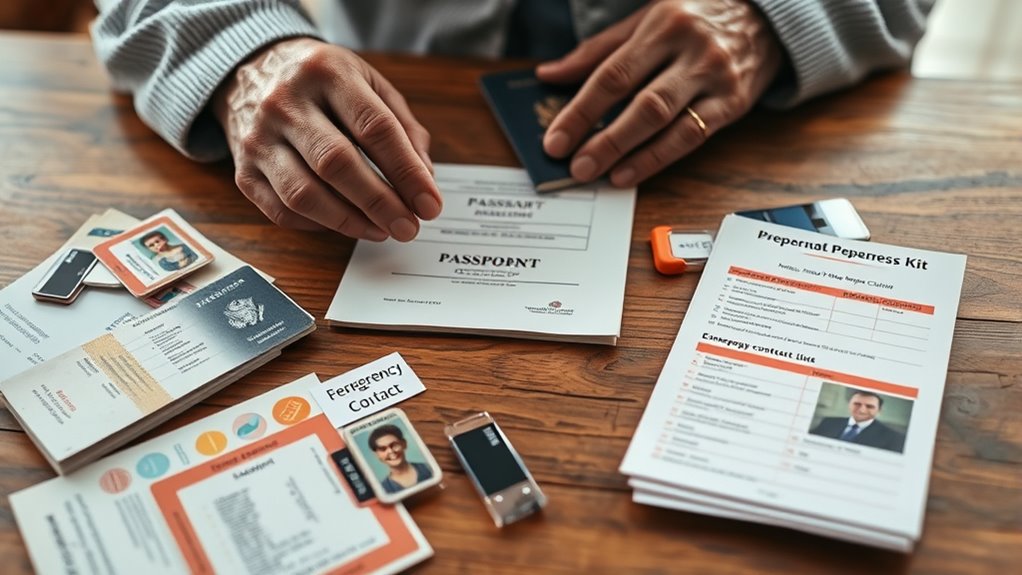
Have you ever considered how quickly important documents and personal identification can become inaccessible during an emergency? Keeping these items organized is essential for medication management and maintaining emotional support. Store copies of your ID, insurance cards, and medical directives in a waterproof, portable folder. Include a list of medications, dosages, and allergies to ensure quick access during emergencies. Consider adding a recent photograph for identification purposes. Make sure loved ones or caregivers know where these documents are kept. Having quick access helps streamline emergency responses, reduce stress, and ensure you receive the right care promptly. Remember, well-organized documents can make a significant difference in maintaining your safety, health, and emotional well-being during unforeseen events.
Emergency Lighting and Power Sources
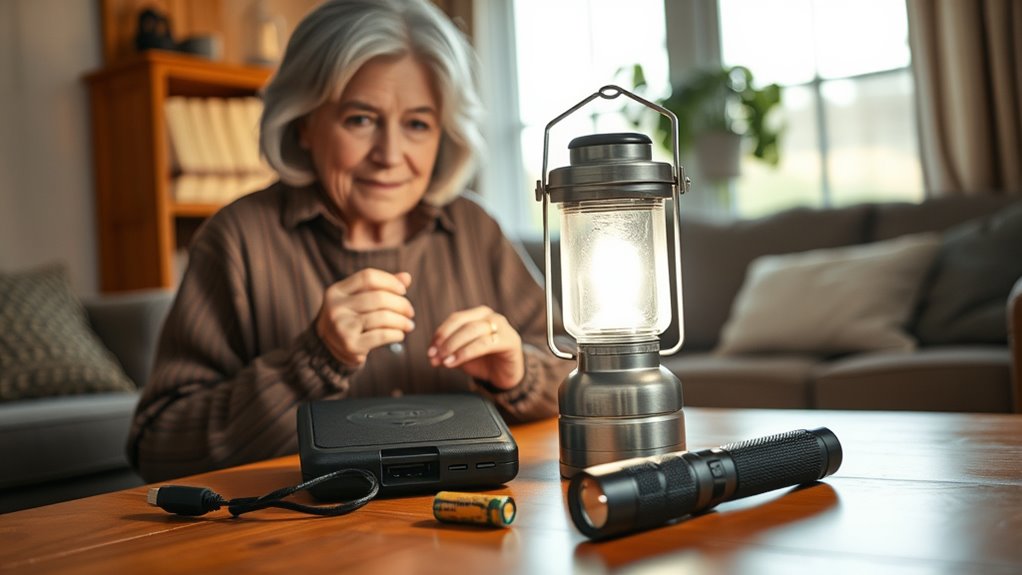
Did you know that reliable emergency lighting and power sources are crucial for ensuring safety during a power outage? You should consider options like solar lanterns and portable generators to keep essential devices running. Solar lanterns are eco-friendly, easy to recharge, and provide bright light without batteries. Portable generators can power medical equipment or charge phones, but require proper handling and fuel storage. Here’s a quick comparison:
| Feature | Solar Lanterns | Portable Generators | Use Case |
|---|---|---|---|
| Power Source | Solar energy | Gasoline or propane | Lighting and device charging |
| Portability | Compact, lightweight | Larger, mobile | Emergency lighting and device backup |
| Recharging | Sunlight | Fuel-based | Continuous use during outages |
| Runtime | Several hours | Several hours to days | Extended power supply |
| Maintenance | Minimal | Regular fuel and oil checks | Long-term reliability |
Regular Maintenance and Updating of the Kit

To guarantee your emergency preparedness kit remains effective, it’s essential to regularly check and update its contents. Conduct routine inspections at least once a month to ensure all items are in good condition and within their expiration dates. During these inspections, focus on kit replenishment by replacing expired medications, worn-out supplies, and depleted batteries. Visualize your kit with these key components:
- Fresh water and non-perishable snacks
- Updated first aid supplies
- Functional flashlights and batteries
Frequently Asked Questions
How Often Should I Review and Update the Emergency Kit?
You should review and update your emergency kit regularly to guarantee it’s ready when needed. Follow a maintenance schedule, like every three to six months, to check expiration dates and replace used supplies. Keep an emergency kit checklist handy to verify essentials are complete. Regular reviews help you stay prepared, ensuring your kit remains functional and up-to-date, giving you peace of mind during emergencies.
What Are the Best Portable Communication Devices for Seniors?
Imagine having a reliable lifeline when you need it most. For seniors, the best portable communication devices include smartphones with emergency contact apps that quickly connect you to loved ones or emergency services. Assistive hearing devices can also enhance communication, ensuring you’re never out of touch. Choose lightweight, user-friendly devices with large buttons and clear displays, so you stay connected and safe no matter where you are.
How Can I Ensure Accessibility for Seniors With Mobility Challenges?
To guarantee accessibility for seniors with mobility challenges, you should choose mobility aids that are easy to handle and operate. Opt for emergency supplies in accessible packaging, like easy-open containers or pre-filled kits. Keep essential items within reach and organized in a designated, accessible space. This way, seniors can quickly find and use what they need during emergencies, reducing stress and promoting independence.
What Specific Medical Supplies Are Critical for Various Health Conditions?
You need to prioritize specific medical supplies for different health conditions, focusing on medication management and mobility aids. Guarantee you have an ample supply of prescriptions, including backups, to prevent interruptions. Include mobility aids like walkers or canes for those with mobility challenges. Also, add items such as blood sugar monitors, inhalers, and emergency medications. Regularly review and update these supplies to meet evolving health needs effectively.
How Should I Store Emergency Supplies to Prevent Damage or Spoilage?
Think of your emergency supplies as a treasure chest; proper storage keeps your valuables safe. You should focus on shelf organization to keep items easy to find and prevent clutter. Climate control is essential—store supplies in a cool, dry place away from direct sunlight to avoid spoilage and damage. Regularly check expiration dates and adjust storage conditions as needed, ensuring everything stays in top shape when you need it most.
Conclusion
By assembling your emergency kit with care, you’re building a fortress of preparedness that shields your loved ones from life’s unpredictable storms. Think of it as planting a resilient tree whose roots run deep, ready to weather any tempest. Regular updates and thoughtful touches turn this kit into a trusted guardian, transforming chaos into calm. With each item in place, you’re not just readying for emergencies—you’re cultivating peace of mind that blossoms even in the darkest hours.









